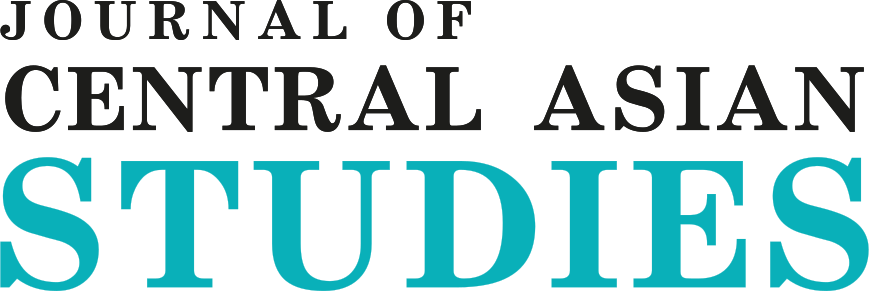Қытай мен Орталық Азияның ынтымақтастығы: жаңа бөтелкедегі ескі шарап па әлде жаңа коктейль ме?
DOI:
https://doi.org/10.52536/3006-807X.2024-2.03Кілт сөздер:
Қытай-Орталық Азия ынтымақтастығы, С+С5, "Белдеу және жол" бастамасы, Жібек жолы, Жаңа ұлы ойын, ИнститутАңдатпа
Орталық Азия соңғы жылдары «Бір белдеу, бір жол» бастамасының және Қытайдың Еуразиядағы үздіксіз ілгерілеуінің, сондай-ақ АҚШ, Жапония, Үндістан және Еуропалық Одақтың аймаққа жаңадан қызығушылық танытуының арқасында маңызды халықаралық назарға ие болды. Соңғысы аймақта «Ұлы ойынды» еске түсіретін институционалдық жарысқа әкелді, ол Питер Хопкирк 19 ғасырда Орталық Азиядағы Ресей мен Ұлыбритания арасындағы бәсекелестікті сипаттау үшін танымал еткен термин. Жаңадан пайда болған «Жаңа Ұлы ойын» Орталық Азия бойынша бірқатар елдер аймаққа еніп, бес «стан» елдерімен ынтымақтастық орнату үшін орнатқан диалогтарға негізделген.
Қытай өзінің геосаяси және экономикалық артықшылықтарын пайдалана отырып, Орталық Азия елдерімен бірқатар байланыс арналарын құрды, соның ішінде 2020 жылы Қытай-Орталық Азия ынтымақтастық механизмі немесе C+C5 және 2023 жылы С+С5 саммиті құрылды. «Бір белдеу, бір жол» бастамасымен және Шанхай ынтымақтастық ұйымымен бірлесе отырып, Қытай өз ықпалын батысқа қарай кеңейтуге және Орталық Азияда қолдау көрсететін аймақтық қоғамдастық құруға нақты мүдделі екенін көрсетті. Қытай мен Орталық Азия ынтымақтастығына назар аудара отырып, бұл мақала Қытайдың Орталық Азиядағы соңғы күш-жігерін және аймақтағы жаңа Ұлы ойынның қозғаушы күші ретінде қызмет ететін басқа да осыған ұқсас бастамаларын қарастырады. Мақалада C+C5 бар бастамалардың бір тармағы ғана емес, Қытай мен Орталық Азия арасындағы одан әрі ынтымақтастық үшін үлкен әлеуеті бар жаңа бастама екені айтылған.
Әдебиеттер тізімі
Abajyan, A. (2021). Shanghai Cooperation Organization as a Platform for Promoting the Agenda of China's Belt and Road Initiative. Banber Arevelagitut'yan Instituti, 1(2), 144-154.
Aidarkhanova, E. (2023, November 23). Why Is the Eurasian Economic Union Broken? Retrieved from The Diplomat: https://thediplomat.com/2023/11/why-is-the-eurasian-economic-union-broken/
Akhtar, M., & Javaid, F. (2021). Is the Shanghai Cooperation Organization Making a “NATO of the East”? Pakistan Journal of International Affairs, 4(3), 599-615.
Avdaliani, E. (2024, February 20). China Uses Crises to Build Central Asia Influence. Retrieved from Europe’s Edge: https://cepa.org/article/china-uses-crises-to-build-central-asia-influence/
Azizi, S. (2024). China’s Belt and Road Initiative (BRI): The Role of the Shanghai Cooperation Organization (SCO) in Geopolitical Security and Economic Cooperation. Open Journal of Political Science, 14, 111-129.
Chao, W. (2022). The Political Economy of China’s Rising Role in the Shanghai Cooperation Organization (SCO): Leading with Balance. The Chinese Economy, 55(4), 293-302.
China, Central Asian Countries Vow to Build Community with Shared Future. (2022). Retrieved from The State Council, PRC: https://english.www.gov.cn/news/topnews/ 202201/27/content_WS61f1f7c6c6d09c94e48a457c.html
China’s Position on the Political Settlement of the Ukraine Crisis. (2023). Retrieved from Ministry of Foreign Affairs, PRC. : https://www.fmprc.gov.cn/mfa_eng/zxxx_662805/202302/t20230224_11030713.html
Evaluation of ADB Support for the Central Asia Regional Economic Cooperation Program, 2011-2021. (2024). Retrieved from Asian Development Bank: https://www.adb.org/sites/default/files/Evaluation%20Document/790821/files/ce-carec.pdf
Hu, B. (2019). Belt and Road Initiative: Five Years on Implementation and Reflection. Global Journal of Emerging Market Economies, 11(1-2), 1-10.
Kaushiki, N. (2013). The New Great Game and India’s Connect Central Asia Policy: Strategic Perspectives and Challenges. Journal of International and Area Studies, 20(2), 83-100.
Khan, J., & Sultana, R. (2021). Sino-Russia Strategic Partnership: The Case Study of Shanghai Cooperation Organization (SCO). FWU Journal of Social Sciences, 15(2), 1-19.
Lei, J. (2023). The Construction of ‘China-Central Asia-West Asia Economic Corridor’ in the Post-COVID Era: Challenges, Prospects and Responses. Journal of Education, Humanities and Social Sciences, 8, 1526-1533.
Li, S. (2023, September 11). China-Central Asia Cooperation Forum Explores Win-Win Opportunities. Retrieved from Xinhua News: https://eng.yidaiyilu.gov.cn/p/0EA3FHN1.html
Murashkin, N. (2020). Japan and the New Silk Road: Diplomacy, Development and Connectivity. London: Routledge.
Nemoto, R. (2023, September 22). Japan Seeks to Boost Central Asia Relations with 1st Summit in 2024. Retrieved from Nikkei Asia: https://asia.nikkei.com/Politics/International-relations/Japan-seeks-to-boost-Central-Asia-relations-with-1st-summit-in-2024
Nurimbetov, R., & Vasa, L. (2021). The Shanghai Cooperation Organization in a Changing Central Asian Geopolitical Context. Academic and Applied Research in Military and Public Management Science (AARMS), 20(2), 27-38.
Popovic, S., & Stevic, L. (2021). The Position of the New Security Concept in China’s Foreign Policy – Case Study on the Shanghai Cooperation Organization. Contemporary Chinese Political Economy and Strategic Relations: An International Journal, 7(2), 717-750.
Pradhan, R. (2018). The Rise of China in Central Asia: the New Silk Road Diplomacy. Fudan Journal of The Humanities and Social Sciences, 11, 9-29.
President Xi Jinping Chairs the Inaugural China-Central Asia Summit and Delivers a Keynote Speech. (2023). Retrieved from Ministry of Foreign Affairs, PRC: https://www.mfa.gov.cn/eng/zxxx_662805/202305/t20230519_11080116.html
Rauf, S., & Saud, A. (2020). Prospects of CSTO and SCO in Regional Politics of Central Asia. International Journal of Politics and Security, 2(4), 30-50.
Rogers, R. (2007). The Shanghai Cooperation Organization, China and the New Great Game in Central Asia. Journal of International Studies, 3, 92-105.
Sachdeva, G. (2022, April 14). India’s Central Asia Challenge. Retrieved from East Asia Forum: https://eastasiaforum.org/2022/04/14/indias-central-asia-challenge/
The New Great Game in Asia. (1996, January 2). Retrieved from The New York Times: https://www.nytimes.com/1996/01/02/opinion/the-new-great-game-in-asia.html
Tsai, T., Hung, M., & Liu, T. (2011). China’s Foreign Policy in Southeast Asia: Harmonious Worldview and Its Impact on Good Neighbor Policy. Journal of Contemporary Eastern Asia, 10(1), 25-42.
Uzakbaev, N., & Movkebaeva, G. (2022). Central Asian States in the Shanghai Cooperation Organization: The Role and Place of the SCO on the Distribution of the Power Balance in the Region. Bulletin Series: International Relations and Regional Studies, 50(4), 34-44.
Yazdani, E. (2020). The Shanghai Cooperation Organization: An Emerging Venue for China’s New Diplomacy. China Quarterly of International Strategic Studies, 6(4), 451-475.
Жүктеулер
Жарияланды
Журналдың саны
Бөлім
Лицензия
Авторлық құқық (c) 2024 Тони Т.Т.

Бұл жұмыс Creative Commons атрибуты бойынша лицензияланған. 4.0 Халықаралық лицензия.










 Open content is licensed under the CC-BY
Open content is licensed under the CC-BY 


